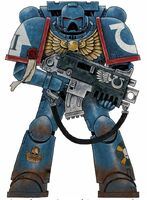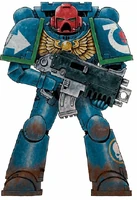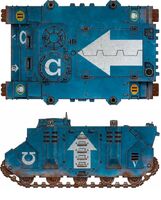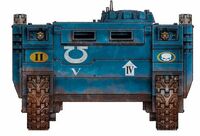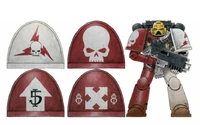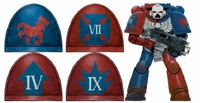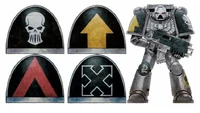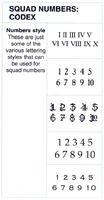"We follow in the footsteps of Guilliman. As it is written in the Codex, so shall it be."
- — Marneus Calgar, Chapter Master of the Ultramarines

Codex Astartes-compliant Space Marine Chapter Tactical Organisation
The Codex Astartes is a great and sacred tome of military organisation, strategy and tactics written by Roboute Guilliman, the Primarch of the Ultramarines Space Marine Legion, to prevent another Horus Heresy. It outlines Guilliman's ideal for the moral behaviour, order of battle and tactical doctrine of a Space Marine Chapter. While not all Space Marine Chapters in the Imperium adhere to the Codex's dictates with the same rigidity as the Ultramarines, most obey the spirit of the Codex if not the actual letter. A Space Marine Chapter that generally follows the guidelines of the Codex Astartes is referred to as a "Codex-compliant Chapter."
With the threat of the Traitor Legions held at bay in the wake of the Horus Heresy and the Great Scouring, Roboute Guilliman turned to ensuring that such a catastrophe could never happen again, distilling his formidable wisdom into a mighty tome known as the Codex Astartes. This text became a major part of his legacy and the cornerstone upon which the future of the Imperium would be based.
Of special interest is the volume of the Codex devoted to the Adeptus Astartes, describing in detail the tactical roles, equipment specifications, uniform markings, command protocols and countless other aspects of Space Marine doctrine. Though for all its multitudinous topics, the most lasting and contentious decree of the Codex Astartes was that the existing Space Marine Legions be broken up and reorganised into smaller organisations known as Chapters. Though many of his brother Primarchs initially railed against Guilliman's decree, almost all eventually accepted the necessity of reorganisation for the security of the Imperium. Thus were the Chapters of the Adeptus Astartes born.
Upon the Codex's implementation, in an event that would become known as the [[Second Founding]], each of the old Legions became a Chapter named for its forebear plus a number of other new Chapters. In addition to a name and heraldry of their own, each of these new Chapters would take for itself a homeworld or fortress-monastery, and use it as a bastion from which to defend the Imperium from all threats. The Codex Astartes stated that each Chapter would be one thousand Battle-Brothers strong and look to its own recruitment, training and equipment. Never again would one man be able to command the awesome, terrifying power of a Space Marine Legion.
The Horus Heresy had also revealed weaknesses in the gene-seed of several Space Marine Legions. These defects had been exacerbated by the accelerated gene-seed cultivation techniques needed to keep the huge Space Marine Legions up to strength. Guilliman believed that the Chaos powers were able to exploit the resultant physical and mental corruption to turn Horus' troops against the Emperor. One of the key objectives of the new Codex Astartes was to recognise and expunge these genetic weaknesses. As a result, the Codex Astartes decreed that Space Marines would forever more be created and trained slowly. The genetic banks used to create Astartes implants would be carefully monitored and scrutinised for any defects. Cultivated organs would be subject to the most stringent tests of purity. Young Initiates would undergo trials of suitability before they were accepted, and only those of the very sternest character would be chosen.
As a final safeguard, Guilliman tasked the Adeptus Terra on Earth with setting up and maintaining genetic banks to produce and store tithes of Space Marine gene-seed. These banks were to provide all new gene-seed for subsequent Foundings of Space Marine Chapters. To prevent cross-contamination, the genetic stock of each Legion was isolated whilst that of the Traitor Legions was placed under a time-locked stasis seal, though at the time many believed they had been destroyed. By taking direct control of these genetic tithes, the Adeptus Terra could ultimately control the Space Marines. They alone had the power to destroy or create Space Marine armies at will.
Over the millennia, there have been many subsequent Foundings of Space Marine Chapters. Those Chapters that adhere rigidly to Guilliman's teachings are sometimes referred to as "Codex Chapters." These Space Marines pride themselves on following the tenets within the hallowed pages of the Codex Astartes and applying its principles of warcraft and devotion to the Emperor.
With the passage of centuries, some Chapters have strayed from the strict letter of the Codex, introducing unique variations on its teachings but remaining broadly faithful to Guilliman's basic principles. Furthermore, the Codex has been reanalysed, reinterpreted and modified countless times over the centuries. Indeed, the Codex Astartes of the late 41st Millennium is a highly developed treatise combining the experiences of hundreds of celebrated military thinkers throughout history. Regardless, the Codex Astartes remains, as it has always been, the Space Marines' authoritative guide to waging war. As such, it is revered by every Battle-Brother as a holy text; the wisdom of the ancients serving as both scripture and the unbending rod by which they are measured.
Most Chapters stick rigidly to the organisation laid down by the Codex Astartes for tactical roles and other processes. Others, such as the Blood Angels, Black Templars and Dark Angels, are organised according to general Codex doctrines but maintain troops, tactics and idiosyncratic traditions that set them apart from their brethren. A small number of Chapters are utterly different from the Codex, and owe nothing to it at all. The most famous of these is the Space Wolves. The sons of Leman Russ have never followed the Codex Astartes -- their strong-willed Primarch moulded his Chapter very much in his own image, irrespective of other influences and dictates.
History
In the wake of the calamity that was the Horus Heresy, the foundations of the Imperium of Man were laid down. The first High Lords of Terra established the structure by which the Adeptus Terra operated, and described the feudal responsibilities and duties of the planetary lords. One of the most important accomplishments was the reorganisation of the Imperium's fighting forces. This was undertaken almost single-handedly by the Primarch of the Ultramarines Legion, Roboute Guilliman, who with characteristic speed and efficiency codified the structure of the Imperial Guard, the Imperial Navy, and the Space Marines. Of all of his works, the most influential is the Codex Astartes, the great prescriptive tome that lays down the basic organisational and tactical rules for the Space Marine Chapters.
The Horus Heresy had revealed previously unknown genetic weakness in the gene-seed of the Primarchs and Space Marines among the original 20 First Founding Space Marine Legions, weaknesses that left the Legions in question greatly exposed to corruption by the Ruinous Powers of Chaos. This risk was exacerbated by the rapid nature of Space Marine recruitment during the centuries between the start of the Great Crusade in ca. 800.M30 and the outbreak of the Horus Heresy itself in the early 31st Millennium. With the Imperium of Man expanding so quickly across the galaxy during the Great Crusade, the need for fresh recruits in the Space Marine Legions was great. So much so that some Legions had not been as particular in their gene-seed screening practices and recruit selection processes as they should have been. The first objective of Roboute Guilliman in writing the Codex Astartes was to both recognise and purge these weaknesses.
Following the end of the Horus Heresy and the retreat of most of the Traitor Legions into the Eye of Terror, the Codex decreed that the nine remaining Loyalist Legions would be divided into 1,000-man Chapters, the Chapter Masters of which would be directly beholden to the Emperor Himself and no other, not even the Primarchs of their original founding Legions (save in the case of the single Chapter that would remain under each Primarch's control and retain its Legion's original name). No one man in the Imperium could ever again control the superhuman might of an entire Legion of 100,000 or more Space Marines.
The Codex outlined a new, more measured process for Space Marine selection and recruitment and insisted that each newly-created Successor Chapter would tithe 5% of its genetic material to the Adeptus Terra and the Adeptus Mechanicus for testing and monitoring. It also decreed that only the Emperor Himself, through the auspices of the High Lords of Terra, would ever again be able to order the creation of a new Space Marine Chapter. All gene-seed would be subjected to the greatest genetic scrutiny before being used in the creation of new Space Marine implants. To prevent cross-contamination, the Codex rebuked the practice of sharing gene-seed between different Chapters and, henceforth different Legions with their different genetic make-ups. From then on, each Chapter would have to rely solely on the gene-seed produced in the bodies of its own Space Marines.
On Terra, the Adeptus Terra created genetic repositories to produce and store Space Marine gene-seed. These banks were used to provide all new gene-seed for Space Marines and, to prevent cross-contamination, the genetic material of each of the old Legions was isolated. Henceforth, the new Space Marine Chapters would receive gene-seed only from their own genetic stock. The remaining gene-seed of the Traitor Legions was placed under a time-locked stasis seal, although at the time, many believed these dangerous stocks should be destroyed. By taking direct control of the genetic stocks, the Adepts of Terra could ultimately control the Space Marines. Now they alone had the power to destroy or create Space Marine Chapters at will.
The Codex also further defined the accepted tactical doctrine, Chapter organisation, order of battle, and recruitment practices for a Space Marine Chapter. It explained the different battlefield roles assigned to each squad of Space Marines in a Chapter, defining them as Tactical, Assault or Devastator Squads and assigning different equipment and purpose to each (see the excerpts below).
There were many other topics covered in the Codex and all of them displayed Guilliman's formidable intelligence and hard-won wisdom. The most controversial and yet most important of the topics and decrees made in the Codex Astartes was that the original twenty Space Marine Legions consisting of 10,000 to upwards of 200,000 Astartes or more, were divided into new Chapters, an existing organisational formation found in the old Legiones Astartes. One Chapter kept the name and colours of the original Legion, while the remaining Chapters took on new titles and colours. Most of the old Legions were divided into fewer than five Chapters, but the Ultramarines, being by far the largest of the Legions, were divided many times. The exact number of new Chapters created from the Ultramarines is uncertain: the number listed in the oldest known copy of the Codex Astartes (the so-called Apocrypha of Skaros) gives the total as 23, but does not name them. These Chapters would consist of ten companies of 100 Space Marines each. The breaking of the remaining nine Loyalist Legions into multiple Space Marine Chapters is known to Imperial historians as the Second Founding, which occurred in ca. 021.M31, seven standard years after the death of Horus.
As a result of the Second Founding, the Ultramarines' gene-seed became the favoured genetic stock of most subsequent Foundings. The new Chapters created from the Ultramarines are often referred to as the Primogenitors, or "first born." All of the Primogenitor Chapters venerate Roboute Guilliman as their founding father and patron. Only one of the original Space Marine Legions, the Space Wolves, has never been broken down into the ten companies decreed in the Codex Astartes. The Space Wolves continue to organize their forces into thirteen "Great Companies," different in organization to those specified by the Codex. Note that the oldest copy of the Codex, the Apocrypha of Skaros, refutes the commonly-held belief that the Space Wolves have never broken down into separate Chapters, stating that two Second Founding Chapters were created from the Space Wolves (Index Astartes I, pg. 13). However, the Space Marine Codex (5th Edition) lists only one Second Founding Successor to the Space Wolves: the Wolf Brothers, who were disbanded at an unknown time in the past because of extreme gene-seed corruption and mutation.
The Codex Astartes further defines the tactical roles, equipment specifications, and uniform identification markings of the Space Marines. These guidelines have evolved over the centuries, and the Codex Astartes of the 41st Millennium is a highly developed treatise combining the wisdom of hundreds of military thinkers throughout history. Some of its contents seem petty and restrictive, hardly worthy of the great mind of a Primarch. Others describe actual battles together with comments on the tactics employed and the decisions of the commanders of the day. As such, the Codex Astartes is revered as a holy text, and many Chapters regard its recommendations as sanctified by the Emperor Himself.
Chapter Organisation
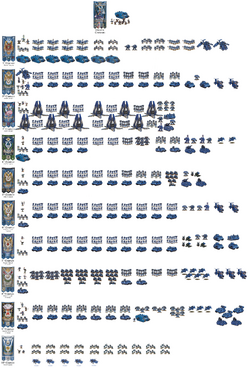
The order of battle of the Ultramarines, the archetypal Codex Astartes-compliant Space Marine Chapter, displaying the full composition of all ten companies
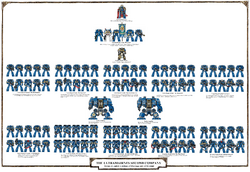
Order of Battle of the Ultramarines 2nd Company, "Guardians of the Temple"; an excellent example of a post-Heresy Codex Astartes-compliant Space Marine company
The Codex Astartes states that a Space Marine Chapter should be split into 10 Companies of 100 Space Marines each, plus a Space Marine Captain, Apothecary, Company Standard and Chaplain for each company. Existing outside the Company level organization, each Chapter has an Armoury consisting of the Chapter's Techmarines, main battle tanks, and other armoured vehicles, a Librarium consisting of the Chapter's Librarians, a Chapter Fleet and the Chapter Master, plus various headquarters staff and the Chapter's Servitors and human Chapter Serfs.
Veteran Company
The 1st Company of a Chapter consists of Veteran Squads and/or Terminator Squads. Support for the 1st Company consists of Land Raiders and Venerable Dreadnoughts. Only the 1st Company may use the hallowed suits of Terminator (Tactical Dreadnought) Armour.
Battle Companies
The 2nd, 3rd, 4th and 5th Companies of a Chapter are known as Battle Companies and they all have the same tactical organisation. Each Battle Company is split into 6 Tactical Squads, 2 Assault Squads and 2 Devastator Squads comprised of 10 Space Marines each. Some companies also make use of Command Squads comprised solely of Veterans to protect their officers or other specialists like Apothecaries and Chaplains. The Assault Squads can instead be deployed as Bike Squadrons or on Land Speeders. Battle Companies often use Rhino and Razorback dedicated transports, and commonly deploy Dreadnoughts for heavy fire support.
Reserve Companies
The 6th, 7th, 8th and 9th Companies of a Chapter are its Reserve Companies. The 6th and 7th are comprised entirely of Tactical Squads, the 8th of Assault Squads and the 9th of Devastator Squads. Like the Battle Companies, the Reserve Companies also make extensive use of Rhino and Razorback transports, though Dreadnoughts are usually only found in the 9th Company. The 6th Company can be entirely deployed on Space Marine Assault Bikes and the 7th on Land Speeders. The 8th Company can use either Space Marine Bikes or Land Speeders. These forces are held in reserve to be deployed at the discretion of Force Commanders as tactical situations evolve, often to bolster weak points or aid in breaking through enemy lines at specific locations.
Scout Company
The 10th Company consists entirely ofScout Squads and is often not 100 strong as recruitment does not provide a steady flow of Neophytes to many Chapters. As such, the 10th Company is the most lightly armed and is most often used as a reconnaissance or guerilla force. Scout Marines are sometimes mounted on Space Marine Bikes, but do not use Rhino or Razorback transports.
Heraldry
The Codex Astartes contains detailed sections pertaining to the heraldry of Space Marine Chapters. These dictate that a Space Marine should display his Chapter's symbol upon his armour's left shoulder guard, whilst his right shoulder guard should show his squad markings. The Codex also states that a Space Marine should incorporate his company's heraldic colour into his armour, displaying it on the trim of his shoulder guards. The Codex suggests a number of variations on this basic system and even advises that each Chapter periodically revise its markings to confound the foe. This has led to myriad differences between the many Codex Chapters and to some having varied their appearance over the millennia.
Each Chapter has its own unique Power Armour colour scheme and Chapter Badge; however, Codex-compliant Chapters all follow a common heraldry system, though there are many slight variations from the system described below.
Company Colours
Each Company has a unique colour that its members wear, commonly on their power armour's shoulder plate rims, but some Chapters use chest eagles, bolter cases, knee pads, helmets or other parts of a Space Marine's Power Armour.
- 1st Company - White or Silver - Members of the 1st Company should also paint their helmet the company colour.
- 2nd Company - Yellow or Gold
- 3rd Company - Red
- 4th Company - Green
- 5th Company - Black
- 6th Company - Orange
- 7th Company - Purple
- 8th Company - Grey
- 9th Company - Blue
- 10th Company - Nominally white, however the company colour is not displayed on the members' armour because they are Scouts.
Squad Markings
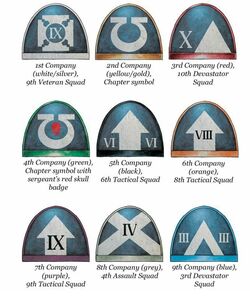
Examples of the Ultramarines' Codex-approved company colours and squad markings

An Ultramarines Sergeant and Veteran Sergeant
The left shoulder plate of a Space Marine in Power Armour always shows the Space Marine's Chapter Badge. Squad markings are shown upon a Battle-Brother's right shoulder guard, except in the case of some older marks of Space Marine Power Armour that instead display them upon knee plates or within the Chapter badge itself. The right plate shows the Squad Badge, which indicates the tactical specialty of the squad the Astartes belongs to and the number of his squad within his company. Veteran Squads use a Maltese Cross, Tactical Squads use an arrow, Assault Squads use four perpendicular arrows pointing outwards and Devastator Squads use an inverted V. Space Marines in Terminator Armour wear the Crux Terminatus on their left shoulder plate, and their Chapter Badge on their right shoulder plate. A Sergeant's badge of rank is the red skull and is often displayed on the left shoulder. The Codex leaves the display of back banners to the Sergeant's discretion. Space Marine helmets frequently display rank and battle honours, either through colour or insignia. Red helmets, for example, are reserved for Sergeants, whilst a white helmet or laurel design denotes Veteran status. Veteran Sergeants typically wear both colours, incorporating a white stripe down the centre of their helm. Whilst company colours are typically displayed on the trim of a Space Marine’s shoulder guards, they can also be displayed on helmets, chest Aquilas, knee plates or even on the squad markings.
Vehicle Markings

Space Marine vehicle tactical specialty markings

Space Marine vehicle company designation roundels; note the colour of the roundel corresponds to the company's Codex-approved colour

Space Marine vehicle identification markings
The Codex Astartes has many pages devoted to regulations for the markings and heraldry of a Chapter's war machines and armoured vehicles. However, just as with Space Marine armour markings, the Codex also warns about complacency and the danger that enemy intelligence can pose. Because of this, the Codex encourages Chapter Masters to occasionally review their markings and offers many variants and alternative icons that can be displayed upon Space Marine main battle tanks.
Space Marine vehicles are generally painted in the livery of their Chapter. In addition to displaying the Chapter's icon, the vehicle's hull is also emblazoned with unit, squad and company markings, although the exact placement and application of these varies according to the Chapter and the vehicle in question. In addition, the most ancient vehicles may display mottos as well as honour badges and names; for their roll of battle victories is as illustrious as that of any breathing hero of the Chapter. Indeed, though every Dreadnought is assigned an identification number, this is quite often superfluous; every one is a famous hero of his Chapter whose names and histories are known even to raw recruits.
Troop transports, Centurion warsuits and armoured vehicles such as Assault Bikes, Attack Bikes and Land Speeders carry the same heraldry and organisational squad markings as the Space Marines that crew, or ride inside them. Space Marine tank crew typically display their vehicle's Chapter numerical designation within a roundel upon their right shoulder guard. Whilst every company maintains a permanent number of Rhino armoured transports, other vehicles are attached based upon an individual mission's requirements.When a vehicle is attached to a company, a small roundel shows the company’s number and/or corresponding colour. Chapter symbols are displayed prominently on the hulls and turrets of Space Marine vehicles. Space Marine battle tanks and Dreadnoughts are assigned a unique identification number within the company. This is typically rendered as a numeral upon the vehicle’s hull.
Army Campaign Badges

Space Marine Campaign Badges
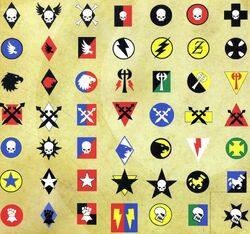
Various Army Campaign Badges worn by the forces of the Adeptus Astartes
When fighting alongside other forces of the Imperium of Man, it is common for the Imperial Commander to choose a simple symbol to act as the campaign badge. This army badge is used for the duration of the campaign and identifies every squad and vehicle in the task force. Normally painted upon the hull of Space Marine vehicles and the greave of a Battle-Brother's armour, it is not uncommon for these badges to be incorporated into an individual’s heraldry as a permanent honour somewhere on his Power Armour after the campaign's completion, either to commemorate exceptional deeds or as a mark of remembrance for the fallen.
Officers and Specialists
- Captains - Wear the heraldry of their company, sometimes embellished with their own personal heraldry.
- Librarians- Wear blue armour, irrespective of what Chapter they belong to, and wear their Chapter Badge as normal. This practice is now widely ignored, even among the more Codex-compliant Chapters.
- Chaplains- Wear completely black armour, irrespective of what Chapter they belong to, and wear their Chapter Badge as normal.
- Techmarines - Wear red armour, irrespective of what Chapter they belong to, and wear their Chapter Badge as normal.
- Apothecaries - Wear white armour, irrespective of what Chapter they belong to, and wear their Chapter Badge as normal.
- Sergeants - Wear the same heraldry as their squad, but carry the squad's banner, which displays the Chapter Badge and the squad's number, plus a red skull (the symbol of a Sergeant). Sergeants often paint their helmets red, or in some cases wear a red skull on their helmet instead.
- Veteran Sergeants - Wear the same heraldry as their squad, but carry the squad's banner, which displays the Chapter Badge and the squad's number, plus a red skull (the symbol of a Sergeant). Veteran Sergeants often paint their helmets red like standard Space Marine Sergeants and add an additional white stripe or laurel wreath that indicates their Veteran status.
- Terminators - Veteran Battle-Brothers, usually of the 1st Company, who make use of Tactical Dreadnought Armour.
Codex-Compliant Chapters
The Chapters that rigidly follow the word of the Codex Astartes are sometimes referred to as "Codex-compliant Chapters" or even simply "Codex Chapters." These Space Marines adhere to the Codex as the model for their organisation, identification markings and tactical doctrine. Of all of the Codex Chapters, the most famous is the Ultramarines, the Chapter of Roboute Guilliman himself. Most Chapters, however, do not adhere so rigidly to the Codex patterns laid down for organisation, tactical roles, or other processes. Many Chapters are organised largely according to the Codex, but are further shaped by their homeworld and the personality of their Primarch. The Blood Angels and Dark Angels are prime examples of this. A small number of Chapters are vastly different from the Codex, and owe little or nothing to it at all. The most famous of these "wild" Chapters are the Space Wolves, whose strong-willed Primarch Leman Russ moulded his Chapter very much in his own image irrespective of other influences.
The Adeptus Terra has never decreed it necessary to enforce the Codex absolutely. Indeed, it is doubtful whether it could. However, with subsequent Foundings, they have always favoured the Ultramarines' gene-seed and created many new Codex Chapters from their line. With the passage of time, some of these Chapters have subsequently strayed from the strict letter of the Codex, introducing new variations but remaining broadly faithful to the principles laid down by Roboute Guilliman many thousands of Terran years before.
Non-Codex-Compliant Chapters
Blood Angels
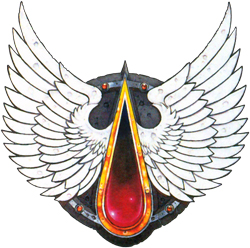
Chapter Badge of the Blood Angels Chapter
The Blood Angels adhere closely to the organisation laid down in Roboute Guilliman's Codex Astartes, and the Chapter's Battle-Brothers are equipped in a similar manner to most other Space Marines. The Battle-Brothers often display a savage desire to engage their foes in the fury of close combat, their rage growing all the stronger the closer to succumbing to the Red Thirst the Blood Angel steps. Most of the time, the Blood Angels are able to hold their curse in check, but those they engage in assault soon discover the bloodthirsty savagery of the sons of Sanguinius. Another known genetic curse that afflicts the Blood Angels and their Successors is the Black Rage, an affliction that overcomes individual Blood Angels as memories and the consciousness of their Primarch Sanguinius intrudes upon their mind. Such a Battle-Brother stands at the end of his travails, for his path leads only to the Death Company, where he and the Chapter's other damned souls will fight one final battle in Sanguinius' name under the guidance of a Chaplain.
Specialist Formations
- Sanguinary Guard - A major deviance from the Codex by the Blood Angels is the existence of the elite Blood Angels Honour Guard known as the Sanguinary Guard, which includes 30 of the Chapter's best and most Veteran Astartes under the command of Brother Sepharan. They use modified Jump Packs with mechanical wings to give them a taste of their Primarch's ability for flight, so that they are transformed into true angels of death. They are clad in ancient suits of golden Artificer Armour, wielding an ancient Power Weapon in the shape of a polearm known as a Glaive Encarmine, each one of which is a Chapter relic dating back many millennia.
- Death Company - The most notable of the Chapter's deviances from the Codex Astartes is the existence of the Blood Angels' infamous Death Company. Not an actual part of the Blood Angels' standard organisation of 10 companies, the Death Company is made up of those unfortunate Astartes of the Chapter who have completely succumbed to the psychosis of the Black Rage. These fanatical and unstoppable berserkers are led into battle by a Sanguinary Priest or a Chaplain, who are the only officers with even a chance of retaining some level of control over these psychotic killers. This company is known as the Death Company because its Astartes are considered to be walking dead men by their brethren. The Space Marines of the Blood Angels Death Company are unstoppable, fighting on with wounds that should kill even a Space Marine.
Specialist Ranks
- Sanguinary Priest - The Blood Angels' Sanguinary Priests are the custodians of the blood of Sanguinius himself. They serve in the role of the Chapter's Apothecaries, as well as partially fulfilling the role of spiritual leaders within the Chapter.
Dark Angels
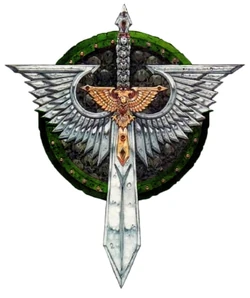
Chapter Badge of the Dark Angels
With the breakup of the Space Marine Legions after the Horus Heresy, the Dark Angels were split into Chapters according to Roboute Guilliman's Codex Astartes. With the exception of two notable formations, known as the Deathwing (1st) and the Ravenwing (2nd) Companies, the Dark Angels follow standard Space Marine combat doctrine, and their dogged resistance against overwhelming odds is legendary. The organisation of the Dark Angels Chapter and its Unforgiven Successors differs from the standards of the Codex Astartes in the shape of its higher echelons, along with the order of battle of its 1st and 2nd Companies.
Specialist Formations
- Inner Circle - The Inner Circle of the Dark Angels Chapter and its Unforgiven Successors is comprised of the Chapter's most senior officers, formed to forever guard the dangerous secrets of the Chapter and its Successors, and each member swears oaths of unspeakable secrecy. The Inner Circle grew from an ad hoc conclave in the I Legion into a formal, if still furtive, organisation that spread through not just the Dark Angels, but their Successor Chapters as well. The Inner Circle is currently comprised of the Dark Angels' Supreme Grand Master, all of the other Grand Masters, the Masters of each of the Chapter's companies, the members of the Deathwing and the Ravenwing Black Knights.
- Deathwing - The Deathwing is the elite 1st Company of the Dark Angels and is also found amongst those Space Marine Chapters who are Successors of the original Dark Angels Space Marine Legion and are collectively known as the Unforgiven. However, the Dark Angels are unusual in that this entire company is only ever fielded as Terminator Squads. The Dark Angels Primarch Lion El'Jonson was betrayed at the end of the Horus Heresy by his second-in-command Luther, who slew the Lion in single combat on the Dark Angels' lost homeworld of Caliban before he and those other Dark Angels who had been corrupted by Chaos were transported into the Warp by the will of the Ruinous Powers. These Traitor Marines are known today as the Fallen Angels, and the Deathwing and all of their Unforgiven kin are sworn to bring every one of the Fallen to repentance or death before they can receive the Emperor's forgiveness.
- Ravenwing - The Ravenwing is the name of the 2nd Company of the Dark Angels Chapter of Space Marines and is also usually used as the name for the 2nd Company of all of the Dark Angels' Successor Chapters, the Unforgiven. The Ravenwing Company is a highly specialised unit that is intended to make use of mobility and speed to defeat the enemy rather than heavy firepower. Like their counterparts from the Deathwing, the Ravenwing are also tasked with hunting down the remaining Fallen Angels.
Specialist Ranks
- Supreme Grand Master - The Dark Angels' Chapter Master is known instead as the Supreme Grand Master. It is his duty to chair all meetings of the Chapter's Inner Circle, which serves as the Dark Angels' replacement for the standard Chapter Council. Only the Supreme Grand Master is privy to all of the Chapter's dark secrets -- and even he does not know everything.
- Grand Master of the Deathwing - The Grand Master of the Deathwing is the Master (Captain) of the Chapter's Veteran 1st Company. He is generally considered to be the natural successor of the current Supreme Grand Master. The Grand Master of the Deathwing usually knows almost all of the secrets of held by the Inner Circle; only the Supreme Grand Master knows more than this veteran officer of the Chapter.
- Grand Master of the Ravenwing - The Grand Master of the Ravenwing serves as the Master (Captain) of the Chapter's highly mobile 2nd Company. The Grand Master of the Ravenwing usually knows as many secrets of the Inner Circle as the Grand Master of the Deathwing, and is normally considered as the natural successor to command the Deathwing when his predecessor falls in battle or is promoted to lead the entire Chapter. The Grand Master of the Ravenwing also serves as the Chapter's Leader of the Hunt; it is his task to run any rumours concerning the possible location of a member of the Fallen to ground anywhere in the galaxy.
- Company Master - A Company Master of the Chapter is the Dark Angels' equivalent to the standard Space Marine Captain of other Chapters. A Company Master leads each of the 10 companies of the Dark Angels and ultimately falls under the command of the Supreme Grand Master. Every Master within the Chapter serves as a member of the Inner Circle, although even at this rank he is not privy to the entire truth surrounding the Chapter's dark past or all of the Chapter's many secrets. To lead the Dark Angels requires a battle-hardened Veteran, a dedicated warrior who has proven his prowess and Chapter loyalty a thousand times over. Such heroes advance into the fabled Deathwing, the 1st Company, but in order to be considered for command, a Space Marine must distinguish himself yet further. Only those who show superlative leadership and tactical skills, and who prove themselves to be absolutely reliable in pursuit of the Chapter's goals, are considered for promotion to officer rank. The Dark Angels do not call their officers by the typical Astartes designation of "Captain," preferring instead to retain the old title used millennia ago by The Order of Company Master. Each Company Master bears additional honorific titles, reflective of his solemn duties within the Chapter. All Dark Angels are taciturn and monastic in nature, and these traits are exemplified by the Company Masters. They shun highly visible, diplomatic roles, avoiding even well-deserved battle laurels and the adulation of their brethren. Where the lauded Captains of other Space Marine Chapters deliver rousing speeches to Imperial coalition forces allied with the Adeptus Astartes, the leaders of the Dark Angels are shadowy figures, more comfortable in cowled seclusion than at the forefront, acting as a skilled orator. Yet for all their silent reservations, Company Masters are no less commanding, though perhaps their grim silence makes them more menacing. With a signal, a Company Master launches the Astartes under his command into action. None can claim to be more disciplined than the Dark Angels; a single barked order can start any number of flawlessly executed manoeuvres. Almost soundlessly, attack plans are orchestrated and fire support coordinated. A Company Master meets each challenge with the same intractable resolve. Such officers are not only superb strategists, but also the most skilled of combatants. Armed with the finest wargear drawn from The Rock's armoury, and with relics maintained since the dawn of the Imperium, a Company Master can cleave through alien hordes or cut down even the mightiest foe in pursuit of a personal challenge. As part of the Inner Circle, a Company Master may join his 1st Company brethren in battle, donning his Terminator Armour and leading one of the most feared combat formations in the galaxy. However, they are most assured in the midst of their own troops, leading their company to victory in the name of the Emperor and the Lion of Caliban. The Company Masters know that they and their Battle-Brothers are descended from the I Legion, the first of the Emperor's Space Marines to be created, and are the favoured Sons of the Lion. They know theirs is a heavy responsibility, for it is their role to both uphold the honour of the Dark Angels, while at the same time seeking to exorcise the secret sins of the ancient past. Only on their orders will the Chapter attain victories, and through them, final redemption.
- High Interrogator - The High Interrogator, also known as the Grand Master of Chaplains, serves as the Dark Angels' Reclusiarch, or High Chaplain, and oversees the duties of all of the other Chaplains of the Chapter. His most important duty is to train the Dark Angels' special class of Interrogator-Chaplains and he is usually a master of their art of interrogation and psychological manipulation. He is a member of the Inner Circle and is thus one of the only members of the Chapter privy to the whole truth surrounding the Fallen.
- Interrogator-Chaplains - The Dark Angels maintain a very special cadre of Chaplains known as Interrogator-Chaplains who are tasked with getting any Fallen Angels who has been captured by the Dark Angels to admit their sins and repent of their betrayal of the Emperor. Interrogator-Chaplains are as skilled in the arts of interrogation, torture and psychological manipulation as the most experienced members of the Inquisition. Interrogator-Chaplains are not members of the Inner Circle, though their duties require that they have knowledge of many more of the Chapter's secrets than is normal for Dark Angels of their rank.
- Deathwing Knight - A Deathwing Knight is a fell-handed warrior of the Dark Angels, a member of the elite 1st Company (the Deathwing) whose glorious deeds on the field of battle are matched only by his unflinching devotion to the Chapter. Deathwing Knights are a truly imposing sight, for in them lives on some semblance of the Lion himself. They embody silent strength and a veiled, yet still palpable nobility.
- Ravenwing Black Knight - Mounted on powerful, heavily customised Mark IV Assault Bikes, the Ravenwing Black Knights of the Chapter's 2nd Company, the Ravenwing, are heavily armed shock cavalry. Those who survive in the Ravenwing long enough learn to take the doctrines of mobile warfare to the next level of mastery. If they can pass the Seven Rites of the Raven, they will be inducted into the Black Knights, the Inncer Circle of the 2nd Company.
Deathwatch
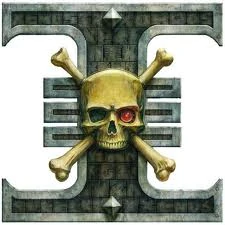
Chapter Iconography of the Deathwatch
Although formally counted as a Chapter, the Deathwatch has a highly unusual organisation since it serves as the Chamber Militant of the Inquisition's Ordo Xenos, which bears little resemblance to that laid down in the Codex Astartes. While a regular, "Codex Chapter" is organised so as to be highly mobile and flexible, and to be deployed almost anywhere in the galaxy on short notice, the Deathwatch often focuses on one threat, in one region. This means that a Watch Commander is able to tailor his forces to the task at hand. Some Watch Fortresses stand guard over vast Ork empires, ever ready to oppose the nigh-unstoppable invasions they periodically unleash. Others guard against more shadowy threats, far harder to detect yet every bit as dangerous. Still more face a myriad of foes and must constantly adapt to an ever-changing strategic situation. The Deathwatch has access to all of the specialised war machines used by other Chapters, and more. Even if a Watch Fortress makes no regular use of such equipment, it keeps mothballed stocks of everything from Attack Bikes to Strike Cruisers, for use as and when required.
In structure, the Deathwatch does not adhere to the strict organisation of squads and companies that the Codex Astartes dictates. The only relevant tactical unit is the Kill-team, which may be organised and equipped in any way the Watch Captains deem appropriate. In one mission the team may go to war on Space Marine Assault Bikes, and in the next mounted on a mighty Land Raider. Those Battle-Brothers with the requisite knowledge might go to war clad in hulking Terminator Armour, or in lightweight Scout Armour with Chameleonic Cloaks. Occasionally, several Kill-teams are combined into a larger force, a sure sign that a highly dangerous foe is to be faced. It is perhaps inevitable that Space Marines new to a term of service in the Deathwatch might experience a period in which they must adjust to this foreign mode of organisation. This is especially the case when it comes to Chapters that adhere rigidly to the Codex Astartes, such as the Ultramarines and their Successors. In practice, a Battle-Brother who could not adjust would not be sent to the Deathwatch, and those that do are often the most highly effective of warriors.
Space Wolves
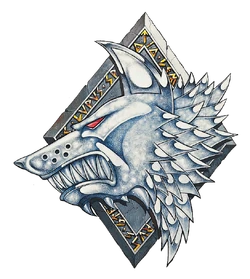
Chapter Badge of the Space Wolves
The Space Wolves are known for their fiercely anti-authoritarian behaviour. They strongly resist the central command structure of the Imperium, organising themselves into Packs instead of the normal squads and continue to refuse the dictates of the Codex Astartes. The Space Wolves only accept some standard Imperial tactics that were considered useful for their own preferred style of warfare. As such, they have a reputation for being as ill-disciplined as they are fearless. It is often said that the best way to get a Space Wolf to do something is to tell him not to do it. The Space Wolves’ combat doctrine is not as organised as that of their brother Chapters. Given that they live for the honour of battle, it is almost certain that the younger Space Wolves will abandon a standard tactical structure in favour of simply rushing headlong at the enemy, howling at the tops of their voices. This has been known to aggravate allies from other units, who must adapt their battle plans in the face of the Space Wolves’ actions. However, far from being uncontrolled berserkers, the Space Wolves simply relish the thrill of close combat above all else. Nonetheless, their battle tactics are undeniably effective; the Space Wolves have fought in such a manner on a hundred thousand battlefields since their conception, and a hundred thousand battle honours bear witness to their bravery.
Specialist Formations
The Space Wolves order of battle contains several specialist formations and officer positions not present in other Space Marine Chapters. Instead of organising into the Tactical, Assault and Devastator Squads as the Codex Astartes dictates, the Space Wolves form their Battle-Brothers into Packs. Each Pack will generally be made up of Astartes who have fought together for some time and will work together as a pack of Fenrisian Wolves do on the hunt. These specialist formations include:
- Wolf Guard - Some Space Wolves, having achieved feats of exceptional valour and martial prowess, may become members of the Chapter's Wolf Guard. These mighty Astartes can lead smaller forces of Space Wolves drawn from other Packs, serve as the Space Wolves' version of an Honour Guard for the most experienced warrior in a deployed Space Wolves force or serve as the Pack leader for a Great Company's squads, imparting their knowledge and experience to their younger charges and serving as the equivalent of standard Space Marine Sergeants.
- Thunderwolf Cavalry - Thunderwolf Cavalry units are a sub-group of the Wolf Guard. According to official Imperial records, the Thunderwolf Cavalry does not exist and the Space Wolves keep them as a closely-guarded secret. Thunderwolves are giant Fenrisian Wolves that stand about the height of a Terran rhinoceros and are used as mounts by the most elite members of the Wolf Guard. Thunderwolves are used in the near-mythical Thunderwolf Cavalry, and are often augmented with adamantium jaws, Imperial bionics, and back-jointed metal limbs that end in razor-sharp blades. The havoc that these creatures are capable of wreaking is said to be startling to even a hardened Veteran Space Wolf.
- Long Fangs - Long Fangs form a cadre of Veteran warriors within the Chapter. Hoary with age, proud and wise, they are quite literally endowed with long fangs, for as a Space Wolf ages his canines lengthen and his hair grows course and grey. After centuries of long wars, their esteem stands as a mountain, commanding awe and respect from those of lesser years. There are relatively few Long Fangs within the Chapter, for many warriors die in battle so only a minority survive to reach a venerable age.
- Grey Hunters - If Blood Claws (newly inducted full-fledged Battle-Brothers) survive long enough to mature into seasoned Astartes, they are promoted to the ranks of the Grey Hunters. These Veteran Astartes are the equivalent of a Codex Astartes-compliant Chapter's Tactical Marines. The Grey Hunter Packs form the greater mass of the Space Wolves' warriors. They are strong and resolute fighters, tempered by battle but as hungry for honour as any proud warrior of Fenris.
- Blood Claws - A Blood Claw is a newly-inducted Astartes of the Space Wolves Chapter and the equivalent of a Codex Astartes-compliant Chapter's Neophyte or Scout Marine. Still struggling to control the spirit of the Wulfen within, Blood Claws are notoriously savage and fiercely aggressive. These hot-headed young warriors cannot wait to prove themselves, charging in howling Packs at the front lines of the enemy in their efforts to garner personal glory.
- Swift Claws - A subset of the Blood Claws, the Swift Claws are culled from the ranks of the Blood Claws when the Chapter needs a swift, hard-hitting assault force comprised of Bike Squads or Land Speeders. The young and ambitious Blood Claws are well suited to this role. In addition to forming a lightning assault force, Swift Claws will occasionally be tasked with a dangerous quest to track down and slay a particularly powerful enemy.
- Skyclaws - Another subset of the Blood Claws, the Skyclaws are culled from the ranks of the Blood Claws when the Chapter needs a swift, hard-hitting assault force and thus serve as the Chapter's Assault Marines equivalent. This specialist unit is composed of the most headstrong troublemakers from each Blood Claw pack and are often "rewarded" by reassignment to a Skyclaw Assault Pack. Entrusted with a Jump Pack, this vital piece of wargear provides the young warrior with the opportunity to indulge in their desire to charge headlong into the thick of battle.
- Wolf Scouts - For some Space Wolves Astartes, the close-knit and boisterous brotherhood of the Pack (squad) is not well suited to their personality, as they yearn for the open spaces and isolation of the Fenrisian tundra. These Space Marines are selected to become part of a Great Company's Wolf Scouts force, providing reconnaissance and disrupting enemy movements.
- Lone Wolves - Over time, as Space Wolves Packs take casualties and gain experience, they pass through the ranks, and eventually the last few survivors make it into the vaunted ranks of the Wolf Guard. However, sometimes a Pack will suffer particularly harsh casualties, leaving a lone survivor who has not yet earned a place in the Wolf Guard. These last standing Lone Wolves will take on an air of vengeance and doom, determined to regain the honour of their Pack in combat or die trying.
- Wolfblade - The Wolfblade is an ancient Honour Guard of Space Wolves that are sent to Terra to protect the ancient Navigator House of Belisarius, long-time allies of the Chapter. They train the Celestarch of Belisarius's House troops and lead them into battle. They act as his strong right arm when there is need. They slay his enemies in open battle and by stealth if need be.
Specialist Ranks
- Great Wolf - The Great Wolf is the Space Wolves' equivalent of a Chapter Master. The Great Wolf is generally considered only a steward of the Chapter rather than its true lord, since he is only awaiting the return of the Primarch Leman Russ who has always been the Space Wolves' only true leader. The Great Wolf leads the Chapter in Russ’ absence.
- Wolf Lords - A Wolf Lord is the Space Wolf officer who is the equivalent of a standard Space Marine Captain and who commands one of the 12 Great Companies that comprise the full Space Wolves Chapter's military force.
White Scars

Chapter Badge of the White Scars
Following the defeat of Horus, during the tumult of the Second Founding, Jaghatai Khan was amongst those Primarchs who willingly embraced the wisdom of Guilliman's great work, the Codex Astartes. Ever since, the White Scars have adhered to the teachings of the Codex, but have always maintained the long-ingrained traditions of their own culture alongside them.
Specialist Formations
- Brotherhoods - The White Scars refer to their companies as Brotherhoods, each of which is slightly smaller than the Codex Astartes dictates. Each company maintains a large stock of vehicles, in particular transports and bikes, and every Battle-Brother is cross-trained in the operation of them all. It is said that the nomads of Chogoris are born in the saddle, and the White Scars are certainly most at ease fighting on, in, or from a mount of some kind. In the time of the Primarch, the Brotherhoods strove for the honour of being declared "First" in the attack, competing in every manner to lead the assault. This practise largely disappeared when the Codex Astartes was applied to the Chapter's organisation and the Legion broken up into Chapters, but it does still resurface when several Brotherhoods fight together. In such instances, the Chapter Master declares which Brotherhood is called "First," as well as the order of attack of the rest of the force. The Brotherhoods keep tally of each battle in which they have been declared First, for the Battle-Brothers know that their deeds will be recounted for all time and their names never forgotten. To be First is such an honour that all tribal feuds are forgotten, the bonds of brotherhood far stronger than those of tribe.
Specialist Ranks
- Khan - A Khan is the officer who commands a White Scars Brotherhood, essentially the Chapter's version of a standard Space Marines Company Captain. Like the Great Khan, the Chapter's Khans are chosen by its Stormseers, who oversee a series of physical, mental and spiritual trials when a vacancy opens to determine which of the White Scars Battle-Brothers is worthy of being elevated to command the fellows of his Brotherhood.
- Master of the Hunt - The Master of the Hunt is an honourific title unique to the White Scars Chapter. The Master of the Hunt is charged with tracking down those rare enemies of the Chapter who have managed to evade destruction at the hands of the White Scars. No enemy is allowed to escape and live and so the Master of the Hunt is charged with hunting those foes and bringing their heads back to the White Scars lands on their homeworld of Chogoris.
- Stormseers - The Zadyin Arga or Stormseers of the White Scars perform the same functions as other Chapters' cadre of Librarians, though the Stormseers emerge from the deeply-ingrained mystical traditions of the tribal shamans and holy men who rode the plains of Chogoris with their Primarch Jaghatai Khan before the coming of the Emperor to Mundus Planus.
- Emchi - The Emchi is the name given by the White Scars in the Chogorian dialect to their Chapter's Apoethecaries.
Codex Astartes Excerpts
"They shall be my finest warriors, these men who give themselves to me. Like clay, I shall mould them, and in the furnace of war forge them. They will be of iron will and steely muscle. In great armour shall I clad them and with the mightiest guns will they be armed. They will be untouched by plague or disease, no sickness will blight them. They will have tactics, strategies, and machines such that no foe can best them in battle. They are my bulwark against the Terror. They are the Defenders of Humanity. They are my Space Marines, and they shall know no fear."
- — Prelude, The Codex Astartes (Apocrypha of Skaros) (Deathwatch: Core Rulebook, pg. 12)
"Let them bestride the galaxy like the gods of old. Sheltering Mankind from destruction at the hands of an uncaring universe."
- — Roboute Guilliman, as laid down in the Apocrypha of Skaros. (Space Marine Codex 5th Edition)
"Consider the magnitude of your duty at leisure, but act without hesitation when action is required."
- — Roboute Guilliman, as laid down in the Codex (Space Marine Codex 3rd Edition, "Legio Astartes Daily Rites")
"The warrior who acts out of honour cannot fail. His duty is honour itself. Even his death -- if it is honourable -- is a reward and can be no failure for it has come through duty. Seek honour as you act, therefore, and you shall know no fear."
- — Roboute Guilliman, (Space Marine Codex, 4th Edition)
"They shall be pure of heart and strong of body, unsullied by doubt and untainted by self-aggrandizement. They will be bright stars in the firmament of battle. Angels of death whose swift wings bring extermination to the enemies of man. So it shall be for a thousand times a thousand years, unto the end of eternity and the extinction of mortal flesh."
- — Roboute Guilliman, (Ultramarines Codex, 2nd Edition
"As you are a knight in service of the Emperor, so is the Rhino your steed. Honour it, respect it, see that its needs are met, and it shall serve you well through all the battles you must face."
- — Roboute Guilliman, as laid down in the Apocrypha of Skaros (Space Marine Codex 5th Edition)
"Of the Tactical Space Marine, bedrock of his Chapter and paragon to his brothers, I shall tell thee. He shall be steeped in the lore of battle and schooled in all manner of weapons and strategy. With Combat Blade, Boltgun and Grenade shall he assail the foe. But these are mere tools: a Tactical Marine's true weapons are his courage, his wits and his dedication to his brothers. He will bring the foe to battle in a manner and time of his choosing, never himself caught unready or ill-prepared for the task at hand. In defence he shall be as stalwart as the mountain, a bulwark stood firm against the enemies of Man. In attack he shall strike with the wrath of the Immortal Emperor, felling the foe without mercy, remorse or fear."
- — Roboute Guilliman, as laid down in the Apocrypha of Skaros (Space Marine Codex, 5th Edition)
"And of the Assault Marine so do I decree: He shall descend upon the perfidious foe as an Angel of Judgement from on high. Let the jump pack be his wings and the roar of its engines a hymn of retribution. Let the chainsword be his sceptre of decree, its harsh voice singing joyfully with each and every blow. With it shall the Assault Marine bring bloody retribution to the heretic, the traitor and all alien transgressors who trespass on the Emperor's domains. So will the Assault Marine be the hunter of warlords and the slayer of kings. His armour shall run slick with the life blood of the vanquished, and all shall honour his name"."
- — Roboute Guilliman, as laid down in the Apocrypha of Skaros (Space Marine Codex 5th Edition)
"A Devastator's reach shall be without limit and his touch without mercy. Fire shall roar from his fingertips, but it shall consume him not. Thunder will roar when he calls, yet it will swallow him not. Let the Devastator Squad be thy blazing wrath, bringing the light of the Emperor's justice to the darkest corners of the battlefield. Wherever he stands, that shall be his fortress of righteousness. He shall hold in his gift the fate of all who pass before his unblinking gaze. All shall fear him, and he shall fear no one."
- — Roboute Guilliman, as laid down in the Apocrypha of Skaros (Space Marine Codex, 5th Edition)
"Use your Bike Squad as a blade, striking the enemy and turning aside his counter-blows in equal measure. But in all things beware that speed is nothing without direction, just as even the mightiest weapon is worthless without careful aim. A Biker's stance should always be resolute and dauntless, but never immobile or rigid. Speed is his advantage, and surprise his deadliest weapon. In fluidity he will find success and in success shall he find renown."
- — Roboute Guilliman, as laid down in the Apocrypha of Skaros (Space Marine Codex, 5th Edition)
"As a commander your tools and devices shall be myriad, yet the wise man knows that battles are won by flesh, not the machine. Flesh can learn, whilst the machine must be forever instructed. Flesh knows loyalty to its brothers and veneration of its Emperor, whilst the machine knows not these things. Whenever the day is darkest and victory in doubt, look not to the machine for aid, but to your Battle-Brothers. The machine can only bring victory if you tell it how such a thing can be done. Your brothers will walk through fire, they will stride through the most terrible carnage at a single word from your lips and they will bring you victory simply because you ask it of them."
- — Roboute Guilliman, as laid down in the Apocrypha of Skaros (Space Marine Codex, 5th Edition)
"Make the Predator's virtues your own. Let your resolve become as impervious as the Predator's armoured hull and let your rage strike with the righteous fury of its guns. As it crushes the foe beneath its remorseless advance, so shall you smite the traitor and the alien without hesitation or regret. Know that to take the field alongside a Predator is to fight at the side of one of mankind's most honoured guardians. To strive with less than your all beneath its Iron Gaze is to dishonour yourself and your Battle-Brothers before one of mankind's greatest heroes."
- — Roboute Guilliman, as laid down in the Apocrypha of Skaros (Space Marine Codex, 5th Edition)
"Know thy duty, and discharge it above all else."
- — Codex Astartes, Chapter IV, Verse 1 (Deathwatch: Rites of Battle, pg. 14)
Sources
- Codex: Blood Angels (5th Edition), pp. 7-8, 25, 27, 40, 80
- Codex: Dark Angels (6th Edition), pp. 11, 14-15, 17, 33, 35, 46
- Codex: Space Marines (6th Edition), pp. 8-15
- Codex: Space Marines (5th Edition), pp. 7-9, 21-22,
- Codex: Space Marines (4th Edition), pp. 7-9
- Codex: Space Wolves (5th Edition), pp. 9, 14
- Codex: Ultramarines (2nd Edition), pp. 9-10, 12-13, 17-19, 22-23, 25, 28-30, 32-36, 39
- Deathwatch: Core Rulebook (RPG), pp. 12-15, 38, 43, 45, 52, 54, 79, 153, 174, 182-184, 312
- How to Paint Space Marines (2004), pp. 34, 36, 38, 40-42, 44-48, 93-95
- Insignium Astartes: The Uniforms & Regalia of the Space Marines by Alan Merrett, pp. 9-38, 40-49, 51
- Index Astartes I, "Codex Astartes: The Holy Tome of the Space Marines," by Rick Priestley and Andy Chambers, pp. 11-16
- Index Astartes III, "Warriors of Ultramar: The Ultramarines Space Marine Chapter," by Graham McNeill, pp. 18, 22
- Warhammer 40,000: Rulebook (6th Edition), pp. 168, 187, 225, 389, 403
- Age of Darkness (Anthology) edited by Christian Dunn, "Rules of Engagement" by Graham McNeill

